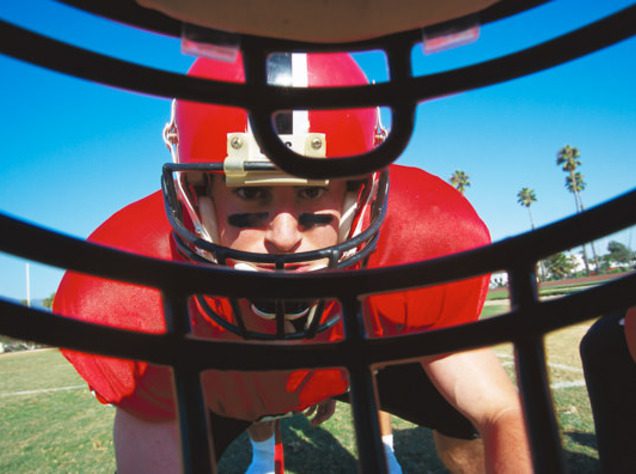In truth, defensive ends are some of the most athletic players in football. In order to succeed at the highest levels, they must be strong enough to push a lineman back, but also fast enough to chase down a running back. From Robert Quinn to JJ Watt, having an elite defensive end is becoming less and less of luxury and turning into an absolute necessity for teams with championship aspirations.
Regardless of high sack numbers, which can often be misleading in terms of analyzing a defensive end’s true value, it’s important to remember that getting pressure on the quarterback is the key to winning any football game. If a quarterback, especially an elite one, has all day to sit back in the pocket then there’s little to no chance of beating them. Learning how to beat your opposition off the snap and making open field tackles aren’t easy, but here are a couple football tips from CoachUp to help you master the position.
Watch Your Opponent
If you’re playing at the high school level, the majority of the plays you’ll see are runs. This can be frustrating because most defensive ends are just waiting for the chance to get a sack. However, if your defensive unit is focused and hardworking, you can swallow up those runs on first and second down to force a third and long pass.
But it’s equally important to remember that your job isn’t just sacks. The defensive end must not let anybody outside you, that goes for quarterbacks, running backs, or wide receivers that catch out of the backfield. Theoretically, if they’ve slipped past you, then you’ve failed your responsibilities for that play.
You can learn a lot about where the play is going by seeing where the offensive lineman steps. He will typically lead you to the hole he is trying to create for the running back, but you have to act fast and beat him there.
)
Play Smart
You’ll drive your coach crazy by constantly trying to guess where the ball carrier is going before he does it. When you’re wrong, you leave your linebackers out to dry with tons of green space around the attacking back. To limit your guessing attempts, make hard initial contact with the lineman and then extend your arms.
Distancing yourself from the offensive lineman will help you see the ball carrier. By not jumping a gap, you force the running back to pick a side of the lineman to run. Once he has made this choice you can put yourself in position to make a stop at the line of scrimmage or at least slow the back down enough for the linebackers to make a play. \
Never Give Up
It may sound cheesy, but as a defensive end you should never give up on a play or your role in it. You never truly know when an opposing player might cut back towards you, fumble the ball, make a mistake, so it’s important that you chase the football from the backfield. Don’t cut across the line of scrimmage. If the opposing coach sees you do this, he will run a reverse.
By cutting across the line of scrimmage, you’re leaving the entire side of the field susceptible to an easy touchdown. If you chase the ball carrier down from behind, it’s much easier to strip the ball because he won’t see you coming.
(Related: Read about the fundamental skills for running backs here.)
Rushing the Quarterback
On third and long, there are few better positions to play than defensive end. The opposing quarterback must hold onto the ball for a longer period of time so this is your time to strike.
Remember, however, to not let the quarterback outside of you — keep him in front of you at any cost. Especially when rushing a mobile quarterback, don’t hastily chase him as he’s able to avoid contract quite easily. On that note, don’t over commit to rushing from outside at too far of an angle, it will allow the quarterback to simply step up in the pocket to avoid your rush.
Finally, if you blow past your lineman too easily, then the call was, most likely, a screen or draw, so get your head up and find the ball wherever it is. To get past your opposition, make hard initial contact with the offensive lineman and extend your arms straight out. From here, you’ll be able to distinguish the play from a pass or run. If it’s a pass, you can use a number of moves to get past your opponent and towards the quarterback.
For example, you’ve got the rip, club, swim, and spin move all at your disposal — master them all and dominate the enemy!
(Related: Read about proper offensive lineman stance here.)
Huddle Up
Of course, this type of stuff can take years of practice and focus before an established, consistent defensive end is born. The best defensive ends like JJ Watt are ready for any situation and he’s made a living off of being prepared for whatever the game throws at him. Watt’s arsenal of moves combined with his ability to never give up on a play has led him to the largest contract in the NFL for a non-quarterback — which is simply incredibly.
If defensive end sounds interesting to you, take these tips with you to the next practice and use them to your advantage. The ability to read a play can only come with time and experience, so consider a private trainer from CoachUp in order to hone in those skills!
Be prepared for the biggest moments by mastering the small ones off the field.
How useful was this post?
Click on a star to rate it!
Average rating 4.5 / 5. Vote count: 63
No votes so far! Be the first to rate this post.



